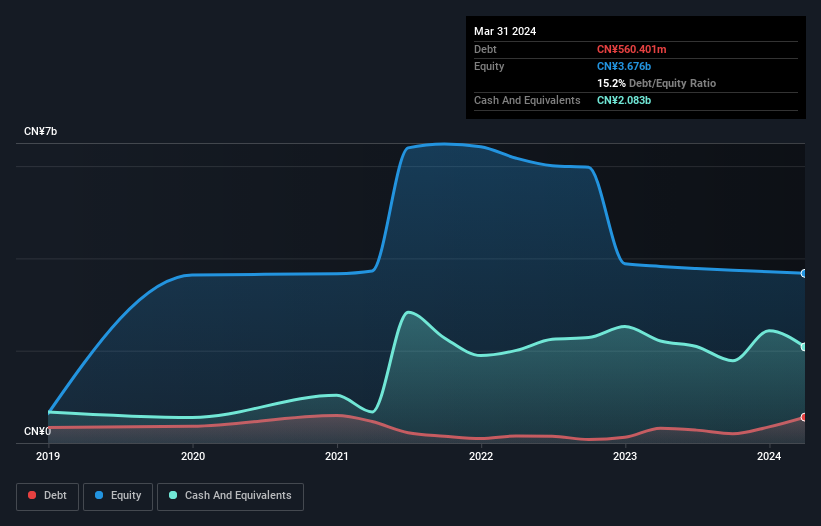- United States
- /
- Specialty Stores
- /
- NYSE:RERE
ATRenew (NYSE:RERE) Has Debt But No Earnings; Should You Worry?
Some say volatility, rather than debt, is the best way to think about risk as an investor, but Warren Buffett famously said that 'Volatility is far from synonymous with risk.' It's only natural to consider a company's balance sheet when you examine how risky it is, since debt is often involved when a business collapses. We can see that ATRenew Inc. (NYSE:RERE) does use debt in its business. But the real question is whether this debt is making the company risky.
When Is Debt A Problem?
Debt is a tool to help businesses grow, but if a business is incapable of paying off its lenders, then it exists at their mercy. If things get really bad, the lenders can take control of the business. While that is not too common, we often do see indebted companies permanently diluting shareholders because lenders force them to raise capital at a distressed price. Of course, the upside of debt is that it often represents cheap capital, especially when it replaces dilution in a company with the ability to reinvest at high rates of return. The first step when considering a company's debt levels is to consider its cash and debt together.
Check out our latest analysis for ATRenew
How Much Debt Does ATRenew Carry?
The image below, which you can click on for greater detail, shows that at March 2024 ATRenew had debt of CN¥560.4m, up from CN¥319.0m in one year. But it also has CN¥2.08b in cash to offset that, meaning it has CN¥1.52b net cash.

How Strong Is ATRenew's Balance Sheet?
The latest balance sheet data shows that ATRenew had liabilities of CN¥1.42b due within a year, and liabilities of CN¥75.4m falling due after that. Offsetting these obligations, it had cash of CN¥2.08b as well as receivables valued at CN¥139.6m due within 12 months. So it actually has CN¥726.6m more liquid assets than total liabilities.
This excess liquidity suggests that ATRenew is taking a careful approach to debt. Because it has plenty of assets, it is unlikely to have trouble with its lenders. Simply put, the fact that ATRenew has more cash than debt is arguably a good indication that it can manage its debt safely. There's no doubt that we learn most about debt from the balance sheet. But it is future earnings, more than anything, that will determine ATRenew's ability to maintain a healthy balance sheet going forward. So if you want to see what the professionals think, you might find this free report on analyst profit forecasts to be interesting.
In the last year ATRenew wasn't profitable at an EBIT level, but managed to grow its revenue by 30%, to CN¥14b. Shareholders probably have their fingers crossed that it can grow its way to profits.
So How Risky Is ATRenew?
While ATRenew lost money on an earnings before interest and tax (EBIT) level, it actually generated positive free cash flow CN¥159m. So although it is loss-making, it doesn't seem to have too much near-term balance sheet risk, keeping in mind the net cash. We think its revenue growth of 30% is a good sign. There's no doubt fast top line growth can cure all manner of ills, for a stock. There's no doubt that we learn most about debt from the balance sheet. However, not all investment risk resides within the balance sheet - far from it. For example, we've discovered 2 warning signs for ATRenew that you should be aware of before investing here.
At the end of the day, it's often better to focus on companies that are free from net debt. You can access our special list of such companies (all with a track record of profit growth). It's free.
New: Manage All Your Stock Portfolios in One Place
We've created the ultimate portfolio companion for stock investors, and it's free.
• Connect an unlimited number of Portfolios and see your total in one currency
• Be alerted to new Warning Signs or Risks via email or mobile
• Track the Fair Value of your stocks
Have feedback on this article? Concerned about the content? Get in touch with us directly. Alternatively, email editorial-team (at) simplywallst.com.
This article by Simply Wall St is general in nature. We provide commentary based on historical data and analyst forecasts only using an unbiased methodology and our articles are not intended to be financial advice. It does not constitute a recommendation to buy or sell any stock, and does not take account of your objectives, or your financial situation. We aim to bring you long-term focused analysis driven by fundamental data. Note that our analysis may not factor in the latest price-sensitive company announcements or qualitative material. Simply Wall St has no position in any stocks mentioned.
Have feedback on this article? Concerned about the content? Get in touch with us directly. Alternatively, email editorial-team@simplywallst.com
About NYSE:RERE
ATRenew
Operates pre-owned consumer electronics transactions and services platform in the People’s Republic of China.
Flawless balance sheet with high growth potential.
Market Insights
Community Narratives




